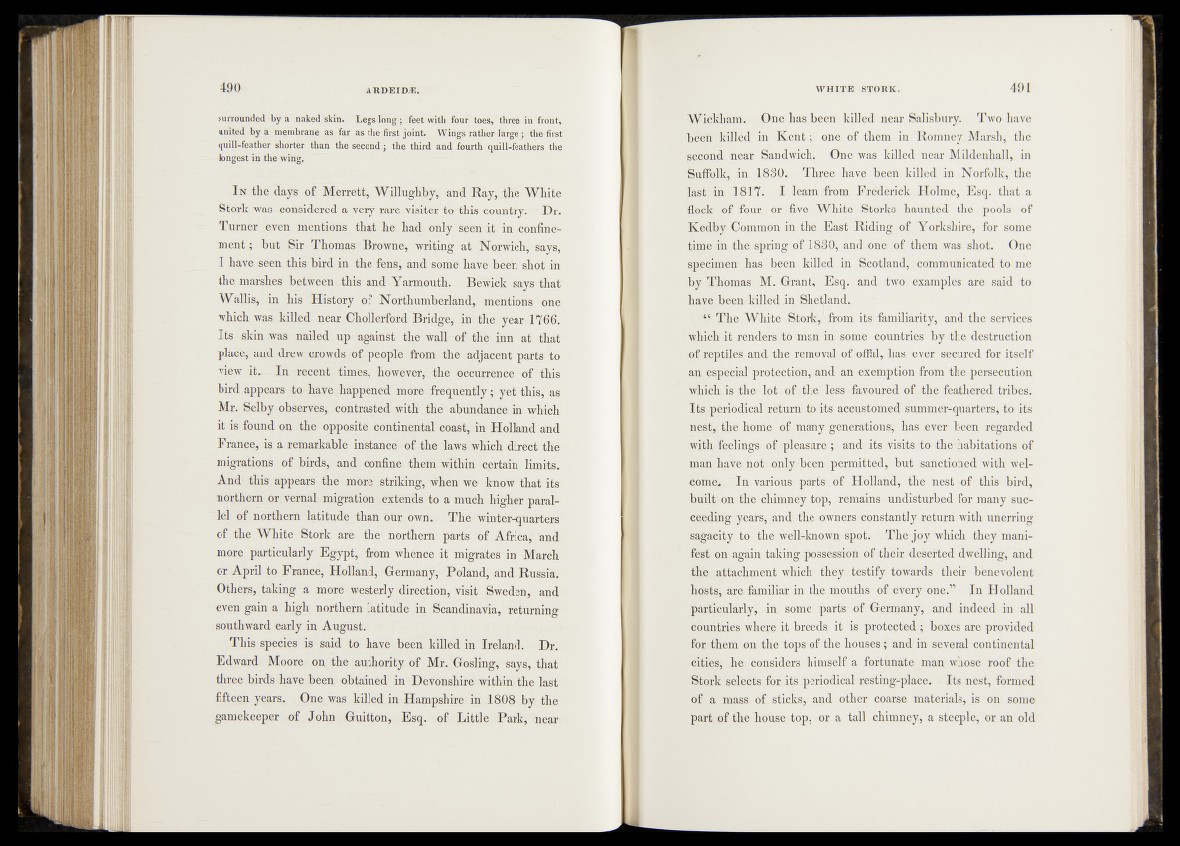
surrounded by a naked skin. Legs icings feet with four toes, three in fronts
united by a membrane as far as the first jqhQ.. Wings rather large ; -the
quill-feather shorter than the second’j the third and fourth quill-feathers the
longest in the wing.
I n the days of Merrett, Willughby, and Ray^jtjie White
Stork was considered a very rare visiter ta this country. Dr.
Turner, „even mentions that he had only sèen it in confinement
; but Sir Thomas Browne^-writing at Norwich, says;
I have seen this bird in the fens, and some havkbeen shot in
the marshes between , this and Yarmouth. Bewick says that
Wallis, in his History of Northumberland, mentions otffr
which was killed near Chollerford Bridge, in the year 1766.
Its skin was nailed up against the wall "of the inn at that
place, and drew crowds of people from r the adjacent parts to
view it* In recent times, howéver;;-the 'occurrence of this
bird appears to have happened more frequently; yet this, as
Mr. Selby observes, contrasted with the abundance in which
it is found on the' opposite continental coast, in Holland and
France, is a remarkable instance of the lawsMnch -direct the
migrations of birds, and confine them within certain limits.
And this appears the more striking, when we- know* that, its
northern or vernal migration extends to a much higher parallel
of northern latitude than our own. The-winter-quarters
of the White Stork are the northern parts of Africa,' and
more particularly Egypt, from whence it migrates in March
or April to France, Holland, Germany, Poland, and Russia.
Others, taking a more westerly direction, visit Sweden, and
even gain a high northern latitude in Scandinavia, returning
southward early in August.
This species is said to hâve been killed in Ireland. Dr.
Edward Moore on the authority of Mr. Gosling, says, that
three birds have been obtained in Devonshire within the last
fifteen years. One was killed in Hampshire in 1808, by the
gamekeeper of John Guitton, Esq. of Little Park, near
Wickham. One has. been killed near Salisbury. Two have
b^eii“killed in R e n t; one of them in Romney Marsh, the
‘‘second near Sandwich; One was killed near Mildenhall, in
'Suffolk, in .183,0. iJTjmee have been killed in Norfolk, the
last in 4817. I learn, from Frederick Holme, Esq. that a
flock • of four or five White ■ Storks. haun.ted the pools of
the vEast Ridmg^J&f,' Yorkshire, for some
time. j.n the^sprin'M^fiihRi-O^ and oit||lof;them was shot. One
sp,<|c.irn4ff 'has. been killed in'.Scotland,;'communicated to me
b&y Thomas, M. Grant,:.Esq. .and two' examples are said to
haiejb#cn -killed .ip Shei^lpndi. ■.
f A 'ThcxWhite Stork, / ’from its'familiarity, and the services
which it4rcJ^dersgto man countries by the destruction
@ff$ept>iles' and the removal of ofial, hasl ever secured for itself
anl|fhpecial prote^ti^p^and aji exemption from the persecution
which is the lot of-the. lcssgsfavoured of the feathered tribes.
ItSj-f)eriodical M§turn t6 its accustomed 'summer-quarters, to its
- nf&t',- the home; of many ge.n'eE$fions;T has ever -been regarded
with phlings of pleasure; - andrdtSf>visits: to the habitations of
man havknot only.beem permitted,', but sanf^Hhe’d with welcome.
kin;vaaaousr parts of Holland, th c ^ e s t of this bird,
builtiihn the chimney topi remains .undisturbed for many succeeding
.*yeafs, and» the ownessrconstantly' return with unerring
sagacity to the well-known spot. T h e ^ y which they manifest
on, again taking possession of their deserted dwelling, and
the attachment which they-testify towards their benevolent
hosts; are familiar in the mouths ofteverypne.?1 In Holland
particularly, in some parts of Germany, and indeed in all
countries where it breeds it is! protected;. boxes are provided
fojr.-them on the tops; of the houses. ;land in several continental
cities, he considers himself a fortunate man whose roof the
Stork selects for its periodical resting-place* ■ Its nest, formed
of a mass of sticks, and other coarse materials, is on some
part of the house top, or a tall chimney, a steeple, or an old